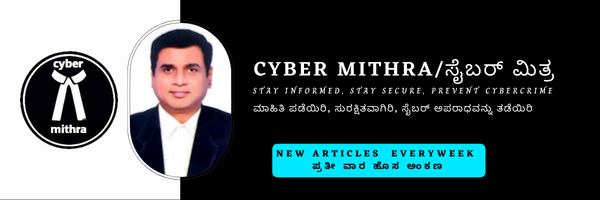Beware! Cybercrimes targeting Women and Girls
Women and children form the more silent and easy targets for the cybercriminals unfortunately, some of the major cybercrimes done on them include cyber stalking, cyber defamation, cyber harassment, revenge pornography, sextortion, cyber bullying, hate speech, cyber hacking, phishing, voyeurism, morphing, deep fakes, cat fishing, identity theft, child pornography, cybersex trafficking, virtual rape, child grooming etc. This week, I am going to talk about three most common cybercrimes against women, which are cyber stalking, cyber defamation and cyber harassment. I had discussed in detail about sextortion, deep fakes and Identity theft cybercrimes before in my articles, please check them out for further details.
How these cybercrimes against women are carried out :-
Cyber Stalking : Stalking refers to an attempt to contact/trace a person through their online details without their consent or post refusal to reveal said information. cyber criminals use electronic communication like email, sms etc. or social media like facebook, instagram etc. and other technology mediums to commit crimes. The crimes include tracking someone and his activities online and using that for blackmail, extortion, identity theft, making false accusations, doxxing or publishing their whereabouts and activities to public etc. Motive behind this crime may include jealousy, obsession, revenge or hatred.
Cyber Defamation : Cyber defamation occurs when with the help of computers and internet someone publishes or spreads derogatory or defamatory information or stories about the victim to all of that person’s friends or to public. If the stories or information published is in obscene or vulgar language or includes picture or videos of the victim them it becomes a cyber sexual defamation. Although this can happen to both genders, but women are more vulnerable. Motive here is to defame or disgrace or take revenge or image/personality assassination.
Cyber Harassment : It is a repeated, unsolicited, hostile behavior by a person through cyberspace or electronic media with a intent to terrify, intimidate, humiliate, threaten, harass or stalk someone. Here harassment may include black mailing, threatening and constant sending of love letters in anonymous names or regular sending of hateful or embarrassing or sexually explicit emails or content on social media. Motive behind this crime include revenge or obsession or hatred or for gaining sexual attention.
How to protect oneself from such cybercrimes :-
- Keep your social media profile locked or private.
- Do not accept friend requests without proper checking their background.
- Do not share your personal and sensitive information including pictures of where you travel or your loved ones in public space, if you want to share with known friends and family only.
- Use good antivirus and a firewall software.
- Do not share your location or travel plans in public.
- Do not respond to strangers messages and block immediately if you are suspicious of them.
- Never, try to meet a person with whom you’ve interacted only online without taking somebody else along and such meeting must always be in a public place.
- Always use strong passwords and keep changing them often.
If you are a victim of such cybercrime :-
Immediately call 1930 cyber helpline or file a complaint at cybercrime.gov.in. Complain to the relevant authority or social media website about such fraudsters and the fraud. Block that user but do not delete any information, instead save them as they will be needed as evidence to prosecute the criminal. If you had installed any software or clicked a hyper link or scanned a QR code provided by fraudster, then uninstall that software, change the passwords/pins of all your important accounts like banking, email etc. Best is to factory reset or format your device as your antivirus may also sometimes fail to find the malware.
Remedies available to victim legally(India) :-
Lodge a complaint at nearby cyber or regular police station under :
- Section 354 A to D(online abuse or crimes against women in cyberspace), Section 378(Theft), Section 424(extract data illegally), Section 441(criminal trespass), Section 499(defamation), Section 500(punishment for slander), Section 503(Threats to harm a person’s reputation), Section 507(Criminal Intimidation), Section 509(Insult privacy and modesty) of Indian Penal Code(IPC)
- Section 43 (Penalty and compensation for damage to computer, computer system, etc), section 66 (punishment for computer related offences – data theft, transmitting virus into a system, destroying data, hacking, or denying access to the computer or network to an authorized person), section 66C(penalties for identity theft and states that anyone who fraudulently or dishonestly uses a person’s identity information), Section 66D (punishment for fraud by impersonation using computer resources), Section 67(publish, transmit, or cause the distribution of obscene content), and Section 67A(publishing, transmission, or facilitating the transfer of sexually explicit content) of The Information Technology Act 2000/08
- Other than this relevant sections from The Immoral Traffic Prevention Act,1956 and Protect children from sexual abuse (POCSO) Act,2012

